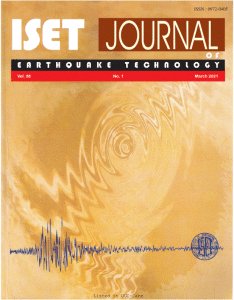Home > Issues & Journals
SEISMIC RESISTANCE OF POCHAMPAD MASONRY DAM
S. S. SAINI* AND M. N. AHMED**
Paper No.: 140
|
Vol.: 11
|
No.: 1
|
March, 1974
|
pp. 1-12

Abstract
Pochampad dam is a masonry gravity dam with earthen flanking bunds and is now in advance stage of construction. The dam was originally not designed for resisting earthquake forces as its site was considered to be non-seismic at the time of plaming and design. Due to the recent seismic activity in the peninsular India, the seismic zening of the country has been revised taking into account the tectonic features and also the three important earthquakes viz. Koyna earthquake 1967), Kothagudem carthquake (1969) and Broach earthquake (1970) which have boen bxtensively investigated. As per the revised seismic zoning of India, Pochampad dam site lies on the periphery of seismic zone I and II. The significant tectonic feature is a fault oriented in NNW–SSE direction known as “Godavari Rift” and it lies about 150 Km. to 300 Km. to the east of the dam site. The recent Kothagudem (1969) earthquake which was widely felt within a radius of 650 Km. can be attributed to this tectonic feature. There is no record of actual seismic intensity experienced at the dam site during this earthquake but on the basis of the available data of known neighbouring places, the estimated seismic intensity experienced was between IV and V on Modified Meroallk Intensity soale. The Pochampad dam site lies near the periphery of the Deccan trap ares in the peninsular India in which Koyna dam is also located. Due to the close diitance Godavari rift from Pochampad dam site and somewhat similar geological conditions prevailing at Pochampad and Koyna dam sites, a Koyna type shock at Poshampad can be expected though not of the same intensity. Therefore in view of the recent revision of the seismic zoning map of the country and also considering the close distance of the Pochampad dam from the fault zone, it is considered necessary to study the seismic resistance of the dam. The dam will be impounding a very big reservoir of capacity 3170 M. cu. m. having a water spread of 453 sq. km. The stability of such a dam under earthquake conditions must be ensured in view of the catastrophic consequences due to the failure of such a dam.
Keywords: Not Available
©2025. ISET. All Rights Reserved.